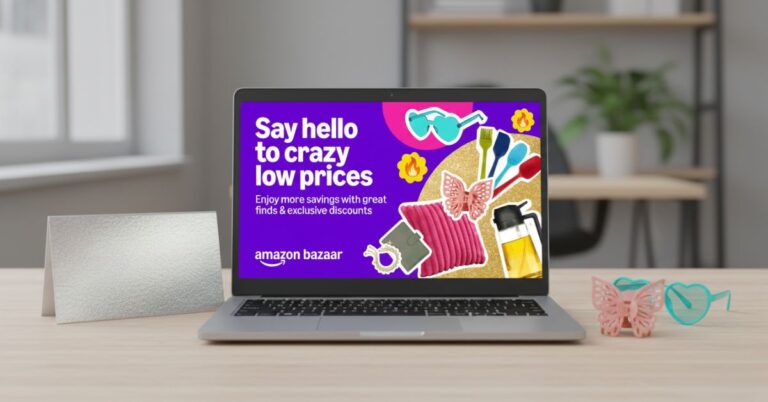
The Amazon Bazaar global expansion introduces a standalone app in 14 new markets, positioning Amazon to compete for budget shoppers against rivals like Temu.
Global inflation continues to pressure consumers, forcing a worldwide shift toward lower-priced goods.
Shoppers are actively “trading down,” with a 0.8% move to cheaper alternatives and a growing preference for private-label goods just to manage their budgets.
For e-commerce giants, this value-seeking trend is a direct threat to high-margin sales, creating a massive opening for competitors like Temu and Shein who thrive on low-price models.
Amazon Bazaar App Launches in 14 New Markets
Morning Consult"Low-cost e-commerce shoppers are often trend-oriented, youthful consumers seeking social status by keeping up with the latest styles."
Amazon announced it has launched a new standalone shopping app, Amazon Bazaar, in 14 new destinations. This move extends the company’s ultra low-price shopping experience, known as Amazon Haul in other regions, to a wider global audience.
The app is now available for download on iOS and Android in the following locations:
- Hong Kong
- Philippines
- Taiwan
- Kuwait
- Qatar
- Bahrain
- Oman
- Peru
- Ecuador
- Argentina
- Costa Rica
- Dominican Republic
- Jamaica
- Nigeria
Amazon stated this expansion follows a positive customer response to the Haul and Bazaar experiences in markets like the U.S., UK, Japan, and Mexico.
A Focus on Ultra-Low Prices and Local Access
The Amazon Bazaar app provides hundreds of thousands of affordable products, with most items priced under $10 and some as low as $2. Customers can browse categories like fashion, home goods, and lifestyle products.
To encourage trial, new customers receive 50% off their first order. The app also features extra savings as customers build their carts and interactive elements like social lucky draws.
The service is designed to be convenient and accessible for local shoppers. Orders that meet a local minimum purchase amount qualify for free delivery, with a standard charge for smaller orders.
Deliveries are expected to arrive in two weeks or less.
Blending Value with the Trusted Amazon Experience
While focused on value, the app retains core Amazon features that build customer confidence. Shoppers can use their existing Amazon credentials to log in.
Customers will also find familiar features, including customer reviews and star ratings. Amazon confirms that all products on Bazaar undergo rigorous compliance checks to ensure safety and adherence to policy.
Additional features supporting this launch include:
- Items can be returned for free within 15 days of receipt.
- The app supports six languages: English, Spanish, French, Portuguese, German, and Traditional Chinese.
- Customers can shop and pay in their local currency using internationally accepted cards like Visa, Mastercard, and American Express.
- A 24/7 multilingual customer support team is available to assist shoppers.
Amazon Bazaar Global Expansion Creates Direct Challenge in New Markets
The Tech Buzz reports that the Amazon Bazaar global expansion marks the company’s strongest entry yet into price-sensitive international markets, directly challenging Temu and Shein. The standalone app now operates in 14 new destinations, bringing Amazon’s sub-$10 product lineup to millions of value-driven consumers.
The launch spans four continents, including countries such as Nigeria, the Philippines, Argentina, and Kuwait. This expansion extends Amazon’s growing ultra-low-price ecosystem, originally established through its Haul platform earlier this year.
The timing aligns with shifting consumer behavior as global inflation drives shoppers to seek affordable products. With Bazaar, Amazon is targeting emerging economies where smartphone use is rising and middle-class consumers demand trusted, low-cost alternatives.
The new app’s structure is designed to compete head-on with Chinese platforms while maintaining Amazon’s reputation for reliability and compliance. By separating Bazaar from its main marketplace, Amazon avoids diluting its premium brand while still offering budget-conscious buyers a competitive option.
Amazon’s early strategy appears calculated. It offers 50% off first orders, free delivery above minimum thresholds, and 15-day free returns—subsidizing acquisition costs to capture market share. This mirrors the company’s proven approach of investing heavily upfront to establish long-term dominance.
The expansion also intensifies competition for PDD Holdings’ Temu and fast-fashion rival Shein, both of which have been rapidly entering the same territories. Amazon’s established logistics network and customer service infrastructure could provide an immediate advantage in fulfillment speed and buyer confidence.
For local and regional retailers, the arrival of Amazon Bazaar represents a major competitive shift. Domestic e-commerce platforms in markets like Nigeria, Ecuador, and the Philippines may struggle to match Amazon’s global supply chain and pricing power.
This expansion underscores Amazon’s recognition that ultra-budget shopping is not a temporary trend but a lasting consumer shift. By investing in Bazaar, Amazon is positioning itself at the center of a global retail realignment where affordability, access, and trust define long-term success.
Consumer Shift Toward Value Fuels Amazon Bazaar Global Expansion
The State of the Consumer 2025: When Disruption Becomes Permanent by McKinsey & Company reveals that inflation and rising costs continue to be the top concerns for consumers across global markets. As a result, shoppers are increasingly trading down to lower-cost alternatives while redefining what “value” means in their purchasing decisions.
The report shows that 79 percent of consumers worldwide are now seeking better deals without necessarily buying fewer products. This shift has made affordability, reliability, and accessibility the primary factors driving consumer choice across both developed and developing economies.
Amazon Bazaar’s global expansion directly aligns with these changing behaviors. By offering sub-$10 products in 14 new markets, Amazon is positioning itself to capture this growing segment of price-conscious consumers who prioritize savings without compromising convenience or trust.
The trend spans demographics, with younger shoppers in particular driving growth in discount and wholesale channels. McKinsey’s findings highlight that 80 percent of U.S. Gen Z consumers shopped at a wholesaler in the past month, underscoring a lasting shift toward budget-friendly retail options.
For Amazon, this consumer pivot strengthens the case for a dedicated ultra-budget platform. Bazaar provides the infrastructure to meet evolving expectations, ensuring that low-cost products are easily accessible while maintaining Amazon’s standards for safety, delivery, and customer experience.
Private Label Boom Reinforces Amazon Bazaar Global Expansion Strategy
Global consumers are sharply increasing their purchases of private label products, a trend driven by high price sensitivity. This finding comes from Simon-Kucher’s Shopper Study 2025, which polled 8,000 shoppers in the US and Western Europe.
Significant inflation since 2020 has forced consumers to make tough choices and shift away from premium brands. Between 55% and 66% of respondents confirmed that price has become an even more important factor for them.
Shoppers reported buying more private-label goods, or store brands, across almost all categories. The largest growth was seen in dairy, dry products, and frozen and fresh produce.
This shift appears to be lasting. Over half of the consumers surveyed said they would buy even more private labels if prices rise further, while 15% plan to increase their private label purchases even if prices stabilize.
More than half of all consumers (53%) now prefer private labels. This preference is strongest in markets like Spain (64%) and France (60%). The lower share in the US (42%) highlights a key area for growth, not just for traditional retailers, but also for e-commerce entrepreneurs.
This gap represents a significant opportunity for sellers to launch their own private-label lines on major platforms, often with the strategic and operational support of a specialized Amazon agency to navigate the competitive marketplace.
While price is the top factor, other concerns are also growing. Thirty-four percent of respondents said they are placing an increasing emphasis on quality, and 28% are prioritizing sustainability.
Hostinger"High prices are the top reason for cart abandonment, affecting 45% of Gen Z, 34% of Millenials, and 32% of Gen X and Boomers."






